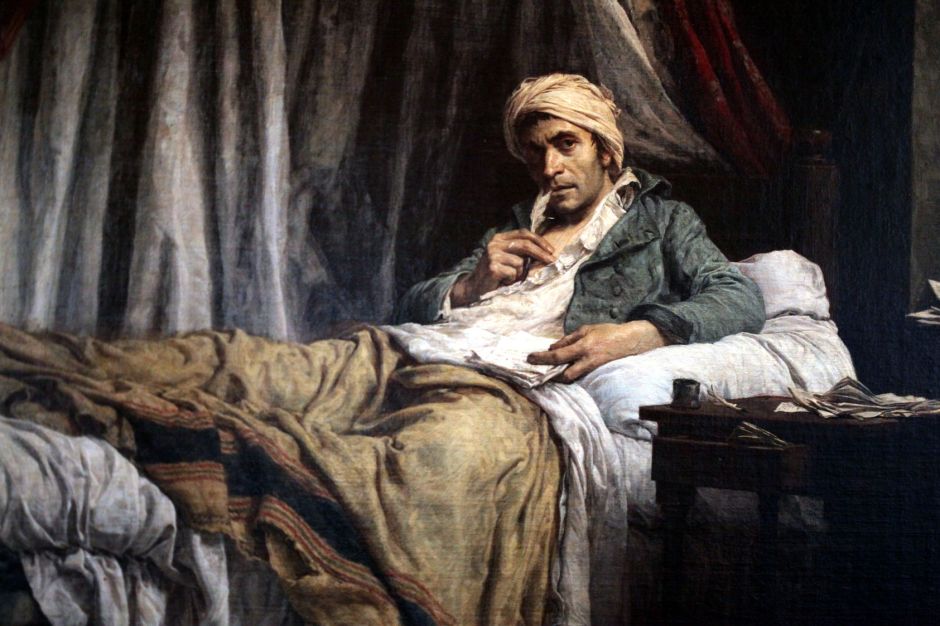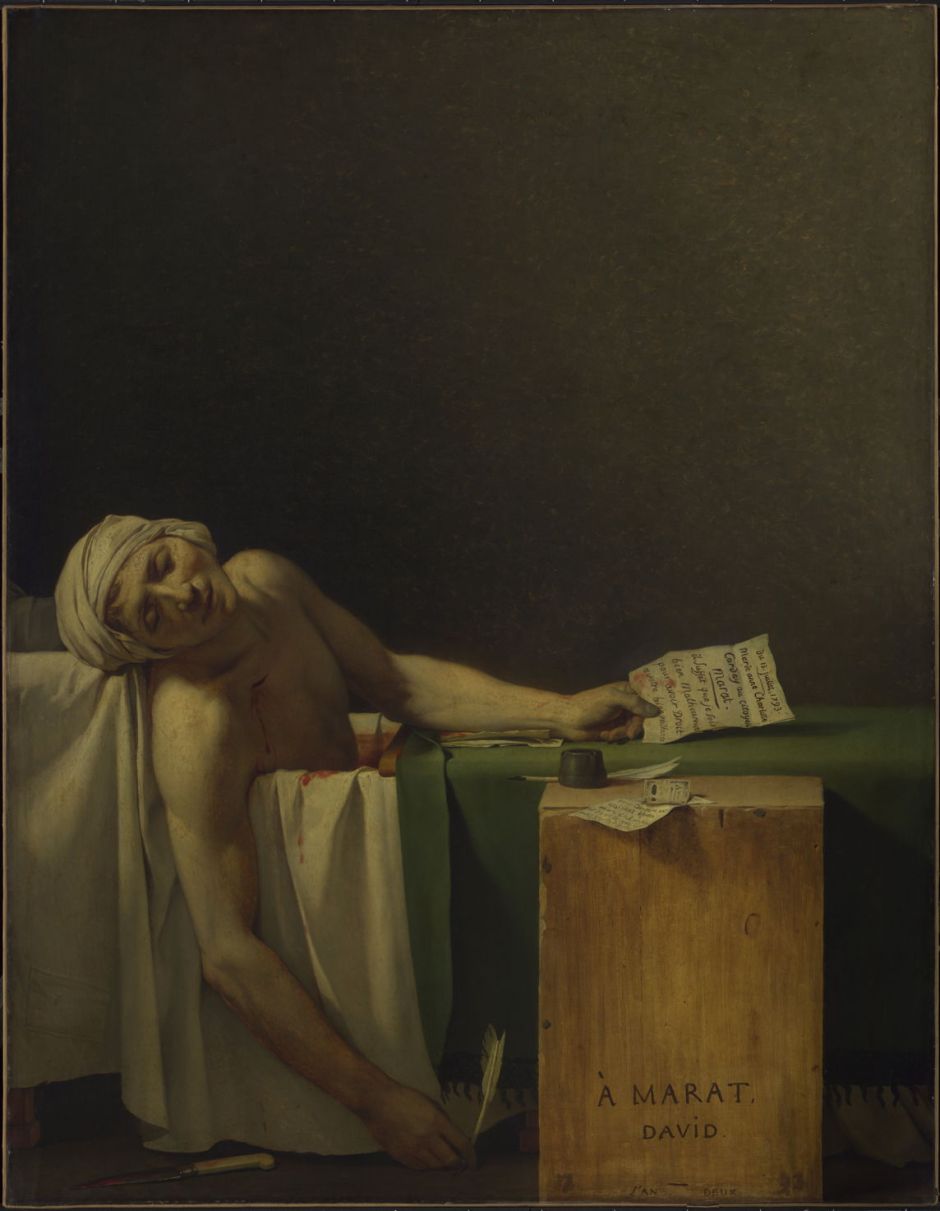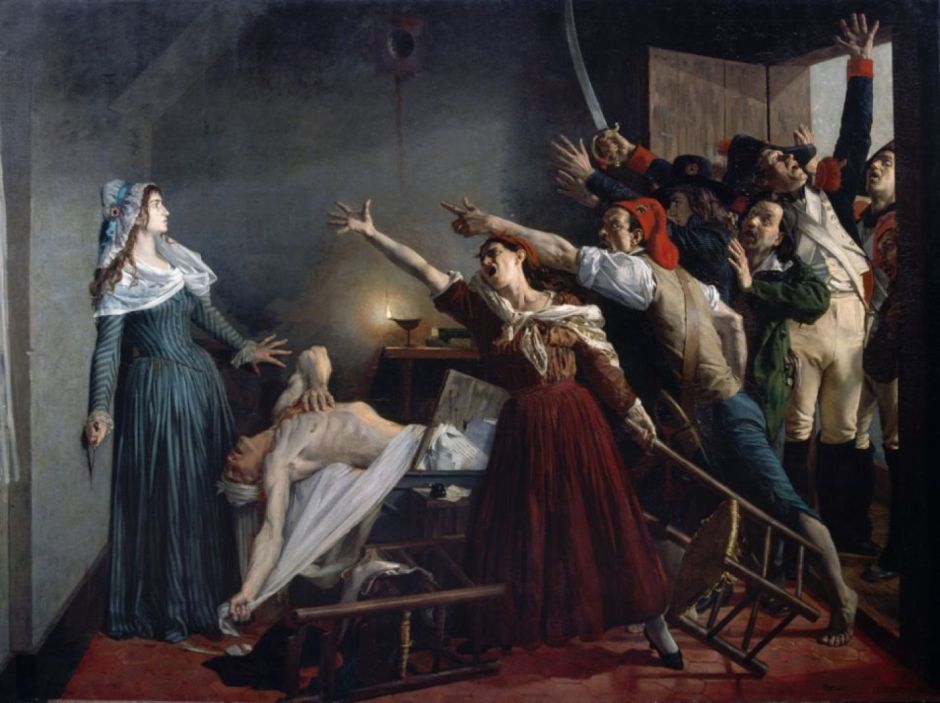The difference between being a national hero and a vile traitor can be narrow and sometimes seem arbitrary. This weekend, in my occasional series looking at narrative paintings featuring women, I consider those depicting the killing of Jean-Paul Marat by Charlotte Corday during the French Revolution. Was she an assassin who deserved execution, or a valiant martyr?
Given the number of prominent people who were killed during the French Revolution, it seems strange that its most famous death was the murder of a Swiss political thinker and journalist by a French woman from the minor nobility. When Charlotte Corday plunged her kitchen knife into the chest of Jean-Paul Marat on 13 July 1793, she can certainly have had no idea how many times that event would appear in paintings.

Marat appears in several paintings, but it’s Lucien-Etienne Melingue’s portrait of him from 1879 that is most relevant, as it depicts him in the role of a great thinker and intellectual, reclining in bed, about to write with his quill.
He was a leading member of the Revolutionary movement, an influential journalist through his newspaper, and a friend of the artist Jacques-Louis David, who had become deeply embroiled in the politics of the Revolution. Because of a severe skin disease, Marat spent much of the time in a bath to ease intense itching.
On the morning of 13 July 1793, Charlotte Corday, a young woman from Normandy, turned up at Marat’s house in Paris asking to see him, but his fiancée turned her away. She gained entry later that evening, and started giving Marat the names of some local counter-revolutionaries. While he was writing them down, she drew a kitchen knife with a 15 cm (6 inch) blade from her clothing, and plunged it into Marat’s chest, killing him rapidly.
Corday then admitted if not boasted of her actions, and on 17 July she was executed in public by guillotine. Marat became a martyr for the cause, after his friend David had organised one of the spectacular funerals for which he had become known.

David’s famous painting shows Marat’s body slumped over the side of his bath, the murder weapon and his quill both on the floor, the pen still in his right hand, and a handwritten note in his left hand.

Corday’s note, here rotated from its orientation in the painting, gives the date, and addresses itself from her to Citizen Marat. It opens with the words “It suffices to say that I am very unhappy to qualify for your kindness”.
This sparse and simple painting became the quintessential image of The Terror in particular, and the Revolution as a whole.

Guillaume-Joseph Roques composed a similar image in The Death of Marat, also painted straight after Marat’s death. It lacks the starkness of David’s, but is almost as effective in making its subject appear a martyr for the cause.
Although Corday had made no attempt to flee the scene of the crime, David and Roques astutely avoid her presence. By the middle of the nineteenth century, during Napoleon III’s Second Empire, Corday’s role was being re-assessed.

Paul-Jacques-Aimé Baudry’s The Assassination of Marat, Charlotte Corday (1860) almost conceals Marat, foreshortening him into a face with a couple of arms. Corday stands powerfully over his corpse, against a large wall map of the nation. She stares resolutely into the distance, the handle of her kitchen knife still protruding from Marat’s chest.
Then, in the midst of France’s calamitous defeat during the Franco-Prussian War of 1870-71, the Second Empire was swept away in favour of the Third Republic. The Paris Commune was brutally crushed, and a protracted struggle eventually put political power into the hands of moderate republicans.

Santiago Rebull’s The Death of Marat from 1875 attempts more of a balance, and from a little more distance. He gives Corday and Marat more equal coverage, shielding both their faces. The scene has also become more theatrical, with sweeping arms and tensed bodies.

Jean-Joseph Weerts’ The Assassination of Marat (1880) looks operatic in its theatricality. Among the crowd pointing and waving are Simonne Evrard (Marat’s fiancée), a distributor of Marat’s newspaper, two neighbours (a military surgeon and a dentist), and Republican troops. Corday is still clutching the knife, and shrinks back against the wall, transfixed.
In the hands of others, Marat’s murder took on different meanings altogether. Edvard Munch used it symbolically to express the trauma he underwent in his disastrous affair with Tulla Larsen.

Munch’s first version of The Death of Marat (1907, above) looks down on the body of Marat/Munch from above, with a nude Corday/Larsen standing to attention next to the corpse. He adjusted the composition for his second version (1907, below), returning to a square-on view with the woman stood in front of Marat/Munch’s bed.


